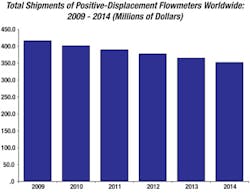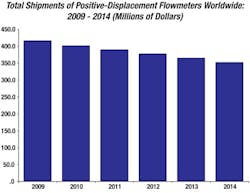Despite growth of such new-technology flowmeters as Coriolis and ultrasonic over the past few years, some traditional technology flowmeters remain popular among end-users. For example, differential-pressure (DP), turbine, positive-displacement (PD), and other more traditional meters are generating significant application demand. The following describes the traditional technology flowmeter market, and explains why this segment remains competitive even in the face of growth in newer flowmeter technology categories.
Traditional technology flowmeters share the following characteristics:
1. As a group, these meters were introduced before the end of World War II.
2. They are less the focus of new product development than new-technology meters.
3. Their performance, including criteria such as accuracy, is not at the same level as the performance of new-technology flowmeters.
4. They generally have higher maintenance requirements than new-technology flowmeters.
5. They are slow to incorporate recent advances in communication protocols, such as HART, FOUNDATION Fieldbus, and Profibus.
Traditional technology flowmeters include DP, PD, turbine, open-channel, and variable-area. Business is brisk with many of these meters. In terms of units, there were more positive-displacement and turbine flowmeters sold worldwide in 2009 than all the new-technology flowmeters combined. Why are customers still so loyal to these meters? While the explanations vary with the type of meter, there are several themes that run throughout.
4 Reasons Traditional Technology Meters Remain Popular
1. Familiarity breeds respect – End-users like having a technology they are familiar with and can understand. DP, PD, and turbine meters in particular are very well known and understood technologies. There is a comfort level among users with these technologies that is less likely to exist with the newer technologies such as, for example, Coriolis and vortex. In cases where more meters need to be added in a plant, users often stick with what they have rather than selecting a different type of meter.
2. Installed base – Some flowmeters, such as DP and PD, have been around for over 100 years. Once these meters are installed, customers find in many cases that it is easier to replace them with meters of the same kind than to switch to another technology. Once a technology is in place, backup parts are readily available, any potential problems are usually known, and the path for replacement is clear. All these are reasons to stick with an existing technology.
3. Industry approvals – Another reason is approvals by standards organizations. For example, PD and turbine flowmeters are approved by the American Water Works Association (AWWA) in the United States and the International Standards Organization (ISO) in Europe for use in custody transfer of water. The AWWA has approvals for both nutating disc and oscillating piston PD meters. While the organization has also formed a working group to consider approvals for magnetic flowmeters, it is continuing to update its standards on PD and turbine meters. This gives PD and turbine meters an edge in the water custody-transfer market.
The effect of approvals is shown by the example of AGA 9, which formulates criteria for the use of ultrasonic flowmeters for custody transfer of natural gas. After the publication of AGA 9 in 1998, the ultrasonic market for natural gas flow measurement received a major boost. Previous AGA publications laid out criteria for the use of DP and turbine meters.
4. Technology improvements – Users are also sticking with traditional technologies because suppliers are bringing out improved products. Turbine suppliers are using material such as ceramic to improve the life of ball bearings. Rosemount, for example, has introduced the 3051S, a pressure transmitter with increased accuracy and stability. PD suppliers are using enhanced manufacturing techniques to build more precision into their PD meters. Communication protocols, such as HART and Profibus, are beginning to appear on turbine and PD meters. All these changes are resulting in improved and more reliable meters for users to choose from.
The Cost of Changing Flowmeter Technology
While end-users are not averse to changing technologies, they are not likely to do so unless they have a specific reason to make this change. One reason is having a problem with the flowmeter. Another is being bought out and having to go with the technology from a new company. Still another is budget requirements that dictate going to a less expensive meter. But changing technologies is not without cost. It usually means taking time to learn a new technology, finding a new supplier, and stocking a different set of backup parts. All these items cost time and/or money.
Traditional Technology Application Strengths
Another reason why users continue to stay with the traditional technologies is that they are genuinely the best solution for certain types of flow applications. Each type of meter has its own set of applications in which it excels. This varies by meter type.
Differential Pressure: DP meters excel at measuring clean liquids, steams, and gases when pressure drop is not a major issue, the application requires low-to-medium accuracy, and price is a consideration. DP flowmeters cause varying amounts of pressure drop, depending on the type of primary element used. Orifice plates cause substantial loss of line pressure, while averaging pitot tubes cause less. DP flowmeters are considerably less expensive to buy than most Coriolis and ultrasonic meters.
Positive displacement (PD) meters are highly accurate meters that are widely used for custody transfer applications. They are widely used for custody transfer of commercial and industrial water, as well as for custody transfer of hydrocarbon liquids to and from delivery trucks and for custody transfer of natural gas. PD meters have the advantage that they have been approved by a number of regulatory bodies for this purpose, and they have not yet been displaced by other applications.
PD meters excel at measuring low flows, and also at measuring highly viscous flows. Because PD meters capture the flow in a container of known quantity, speed of flow doesn’t matter to a PD meter. They also do well with liquids that would give other meters headaches, like honey.
While PD meters excel at measure low flows, turbine meters do best with steady, high-speed flows. Turbine meters also are more adaptable to large pipe sizes, including line sizes over 12 inches, than are PD meters. There at least eight different types of turbine meters, and each one is designed for a specific set of applications.
Open Channel: Open-channel meters are the only game in town when it comes to open-channel applications. However, there are different types of open channel meters. Open channel applications are defined as those in which liquid flows in a stream or conduit that is not closed, or liquid flowing in partially full pipes that are not pressurized.
Some open-channel flowmeters require hydraulic structures such as weirs or flumes; these are similar to the primary elements used with DP meters. Flow passes through the weir or flume, and flowrate is calculated based on the level or depth of the flow as it passes. Another popular method is called velocity area. Using this method, the velocity of the stream is computed by one method (e.g., electromagnetic), and the level or depth of the stream is computed, usually by another method (e.g., radar). These values are then used to calculate flowrate, although the area of the flow must also be known.
Variable Area: Most variable-area flowmeters consist of a tapered tube that contains a float. The upward force of the fluid is counterbalanced by the force of gravity. The point at which the float stays constant indicates the volumetric flowrate, which can be often read on a scale on the meter tube. Variable-area meter tubes are made of metal, glass, and plastic. Metal tubes are the most expensive type, while the plastic tubes are lower in cost. Metal tubes are used for high-pressure applications.
While most variable-area meters can be read manually, some also contain transmitters that generate an output signal that can be sent to a controller or recorder. While VA meters should not be selected when high accuracy is a requirement, they do very well when a visual indication of flow is sufficient. They are very effective at measuring low flowrates, and can also serve as flow/no-flow indicators. Variable-area meters do not require electric power and can safely be used in flammable environments.
What the Future Holds
Positive-displacement and turbine flowmeters are being displaced for some applications by new-technology meters, especially Coriolis and ultrasonic. Meanwhile, differential-pressure and turbine meters are being displaced by ultrasonic flowmeters for custody transfer of natural gas. Nevertheless, differential-pressure, positive-displacement and turbine flowmeters remain viable choices for many types of liquid and gas applications. Positive-displacement flowmeters are well suited to measure low flows, while turbine meters are better suited for medium to high-speed flows. Much of the future for traditional meters depends on how quickly standards bodies approve new-technology meters for applications currently dominated by traditional meters. Only time will tell.
Jesse Yoder, Ph.D., is president of Flow Research Inc. in Wakefield, Mass., a company he founded in 1998. He has 22 years of experience as an analyst and writer in process control. Yoder specializes in flowmeters and other field devices, including pressure and temperature products. He has written over 110 journal articles on instrumentation topics. Dr. Yoder can be reached at [email protected].
www.flowresearch.comThe content of this article is based on results found in Flow Research’s recently published “Volume X: The World Market for Flowmeters, 3rd Edition” study, which covers all flowmeter types. For more information on this study, visit www.floweverything.com.




